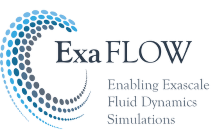Aothors: Martin Vymazal, David Moxey, Chris Cantwell, Robert M. Kirby and Spencer Sherwin
High-order methods, combined with unstructured grids, are now becoming increasingly popular in application areas such as computational fluid dynamics. They simultaneously provide geometric flexibility and high-fidelity of flow solutions, whilst being able to utilise modern computing hardware more effectively than traditional low-order methods. These properties make high-order methods particularly attractive in various application areas such as large-eddy simulations over complex industrial geometries, which can be used to gain detailed insight into flow physics.
- Details
- Written by Lena Bühler
- Category: News
- Hits: 5760
Read more: Weak Dirichlet Boundary Conditions and Hybrid DG on Groups of Elements
Author: Nicolas Offermans, KTH Royal Institute of Technology
In our previous blog posts, we presented our progress on the implementation of h-type mesh refinement capabilities in the spectral element method (SEM) code Nek5000. For the next step, we combine these tools with appropriate error estimators and we perform adaptive mesh refinement (AMR) on some test cases. Two methods are considered for estimating the error. The first method uses selected spectral error indicators, which are based on the properties of the SEM. The second one uses dual error estimators, which are based on the computation of an adjoint problem. At the moment, only steady and two-dimensional simulations are considered. Yet, the results obtained provide a valuable experience before an application to the real-world benchmarks/test cases of the ExaFLOW project in the future. A detailed description of our latest work can be found in [1].
- Details
- Written by Lena Bühler
- Category: News
- Hits: 4576
Read more: Adjoint error estimators for the spectral element method
Authors: Neil D. Sandham, Roderick Johnstone, Christian T. Jacobs
Direct numerical simulation (DNS) of turbulent flow is highly accurate, capable of resolving all turbulence length scales with the numerical grid. However, applications of DNS are limited due to the sheer computational cost of the approach, since the number of grid points scales very strongly with the Reynolds number (e.g. Re(37/14) for aerofoil boundary layer flow [1]).
- Details
- Written by Lena Bühler
- Category: News
- Hits: 2919
Read more: Heterogeneous modelling: Combining LES and quasi-DNS to simulate turbulent channel flow
Author: Nick Johnson, EPCC
Use cases are the bridge between benchmarks, where specific elements of a code are exercised (often in isolation) such as a solver, or IO routine and full applications. However, that’s not to say use cases are not full applications. In ExaFlow, our use cases are specific geometries, specific CFD problems that we use to demonstrate the improvements we have made to our co-design applications: Nektar++, Nek5000 & OpenSBLI. What differentiates them from full applications is that we already know the answer! Like a school kid sneaking a look at the answers in the back of the textbook, we have a good feel for how the model should resolve, what is should look like, and perhaps more importantly, what it shouldn’t look like.
- Details
- Written by Lena Bühler
- Category: News
- Hits: 3274
In mid-September, the ExaFLOW consortium gathered with members of the Scientific Advisory Board in the impressive surroundings of the mid-nineteenth century mansion St Leonard's Hall in Edinburgh. This all-hands meeting allowed everyone to be updated on the project’s achievements during the last six months and set the agenda for the final year.

- Details
- Written by Lena Bühler
- Category: News
- Hits: 2916
Page 2 of 7



